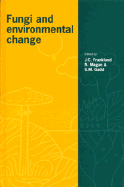Book contents
- Frontmatter
- Contents
- List of contributors
- Preface
- 1 Effects of climate change on fungal diseases of trees
- 2 Effects of climate change on Fusarium foot rot of winter wheat in the United Kingdom
- 3 Effects of UV-B radiation (280–320 nm) on foliar saprotrophs and pathogens
- 4 Implications of global warming and rising sea-levels for macrofungi in UK dune systems
- 5 Red Data Lists and decline in fruiting of macromycetes in relation to pollution and loss of habitat
- 6 Effects of dry-deposited SO2 and sulphite on saprotrophic fungi and decomposition of tree leaf litter
- 7 Effects of atmospheric pollutants on phyllosphere and endophytic fungi
- 8 Influences of acid mist and ozone on the fluorescein diacetate activity of leaf litter
- 9 Mycorrhizas and environmental stress
- 10 Myccorhizas, succession, and the rehabilitation of deforested lands in the humid tropics
- 11 Potential effects on the soil mycoflora of changes in the UK agricultural policy for upland grasslands
- 12 Uptake and immobilization of caesium in UK grassland and forest soils by fungi, following the Chernobyl accident
- 13 Effects of pollutants on aquatic hyphomycetes colonizing leaf material in freshwaters
- 14 Fungi and salt stress
- 15 Fungal sequestration, mobilization and transformation of metals and metalloids
- 16 Urban, industrial and agricultural effects on lichens
- 17 Fungal interactions with metals and radionuclides for environmental bioremediation
- 18 Impact of genetically-modified microorganisms on the terrestrial microbiota including fungi
- 19 Has chaos theory a place in environmental mycology?
- Index of generic and specific names
- Subject index
13 - Effects of pollutants on aquatic hyphomycetes colonizing leaf material in freshwaters
Published online by Cambridge University Press: 05 November 2011
- Frontmatter
- Contents
- List of contributors
- Preface
- 1 Effects of climate change on fungal diseases of trees
- 2 Effects of climate change on Fusarium foot rot of winter wheat in the United Kingdom
- 3 Effects of UV-B radiation (280–320 nm) on foliar saprotrophs and pathogens
- 4 Implications of global warming and rising sea-levels for macrofungi in UK dune systems
- 5 Red Data Lists and decline in fruiting of macromycetes in relation to pollution and loss of habitat
- 6 Effects of dry-deposited SO2 and sulphite on saprotrophic fungi and decomposition of tree leaf litter
- 7 Effects of atmospheric pollutants on phyllosphere and endophytic fungi
- 8 Influences of acid mist and ozone on the fluorescein diacetate activity of leaf litter
- 9 Mycorrhizas and environmental stress
- 10 Myccorhizas, succession, and the rehabilitation of deforested lands in the humid tropics
- 11 Potential effects on the soil mycoflora of changes in the UK agricultural policy for upland grasslands
- 12 Uptake and immobilization of caesium in UK grassland and forest soils by fungi, following the Chernobyl accident
- 13 Effects of pollutants on aquatic hyphomycetes colonizing leaf material in freshwaters
- 14 Fungi and salt stress
- 15 Fungal sequestration, mobilization and transformation of metals and metalloids
- 16 Urban, industrial and agricultural effects on lichens
- 17 Fungal interactions with metals and radionuclides for environmental bioremediation
- 18 Impact of genetically-modified microorganisms on the terrestrial microbiota including fungi
- 19 Has chaos theory a place in environmental mycology?
- Index of generic and specific names
- Subject index
Summary
Introduction
Leaf material is an important primary energy source in many northern temperate streams and rivers (Bärlocher & Kendrick, 1981). It is utilized by various macroinvertebrates which may be classified in terms of their feeding biology. Coarse particulate organic matter (CPOM; particle size > 1 mm) is utilized by a group described as the ‘shredders’. These macroinvertebrates begin the incorporation of leaf material into the food web both by consumption and by producing fine particulate organic matter (FPOM), in the form of leaf fragments and faeces. FPOM (particle size < 1 mm) is utilized by a group of macroinvertebrates described as collectors. Both shredders and collectors are utilized by predators (Cummins, 1973; Anderson & Sedell, 1979).
The utilization of leaf material by shredders is therefore important to the community as a whole. Leaf material that has recently entered freshwaters is of low food quality for macroinvertebrates, as soluble compounds such as sugars and amino acids are rapidly leached into the surrounding waters. What remains after leaching are refractory compounds such as cellulose, pectins and lignin (Nykvist, 1962; Petersen & Cummins, 1974). When leaf material enters freshwater it is rapidly colonized by microorganisms and, especially in the early stages of decomposition, fungi dominate. Although some terrestrial fungi will be present on leaf material as it enters water, they are poorly adapted to conditions attained in temperate freshwaters and therefore do not persist (Bärlocher & Kendrick, 1974). In contrast, aquatic hyphomycetes are well adapted to the freshwater environment.
- Type
- Chapter
- Information
- Fungi and Environmental Change , pp. 201 - 216Publisher: Cambridge University PressPrint publication year: 1996
- 2
- Cited by

